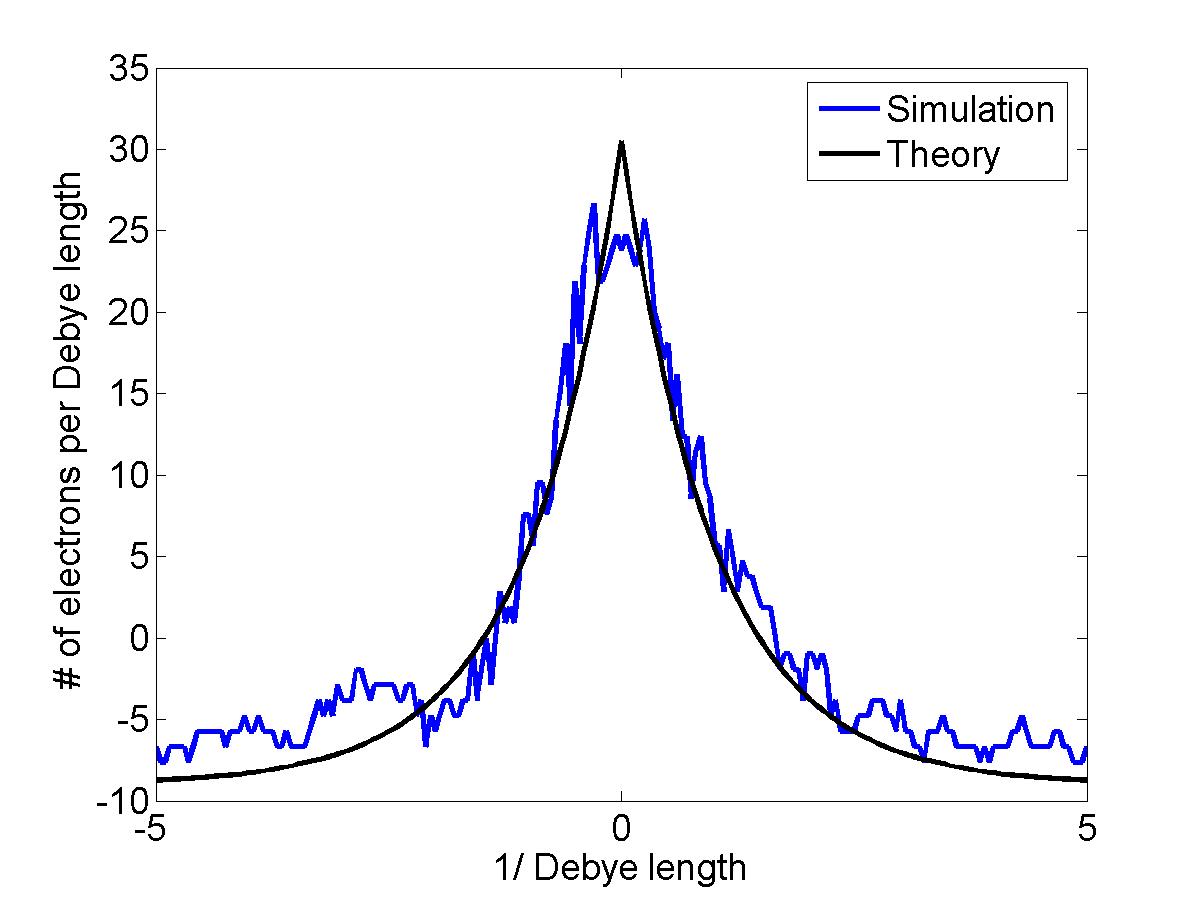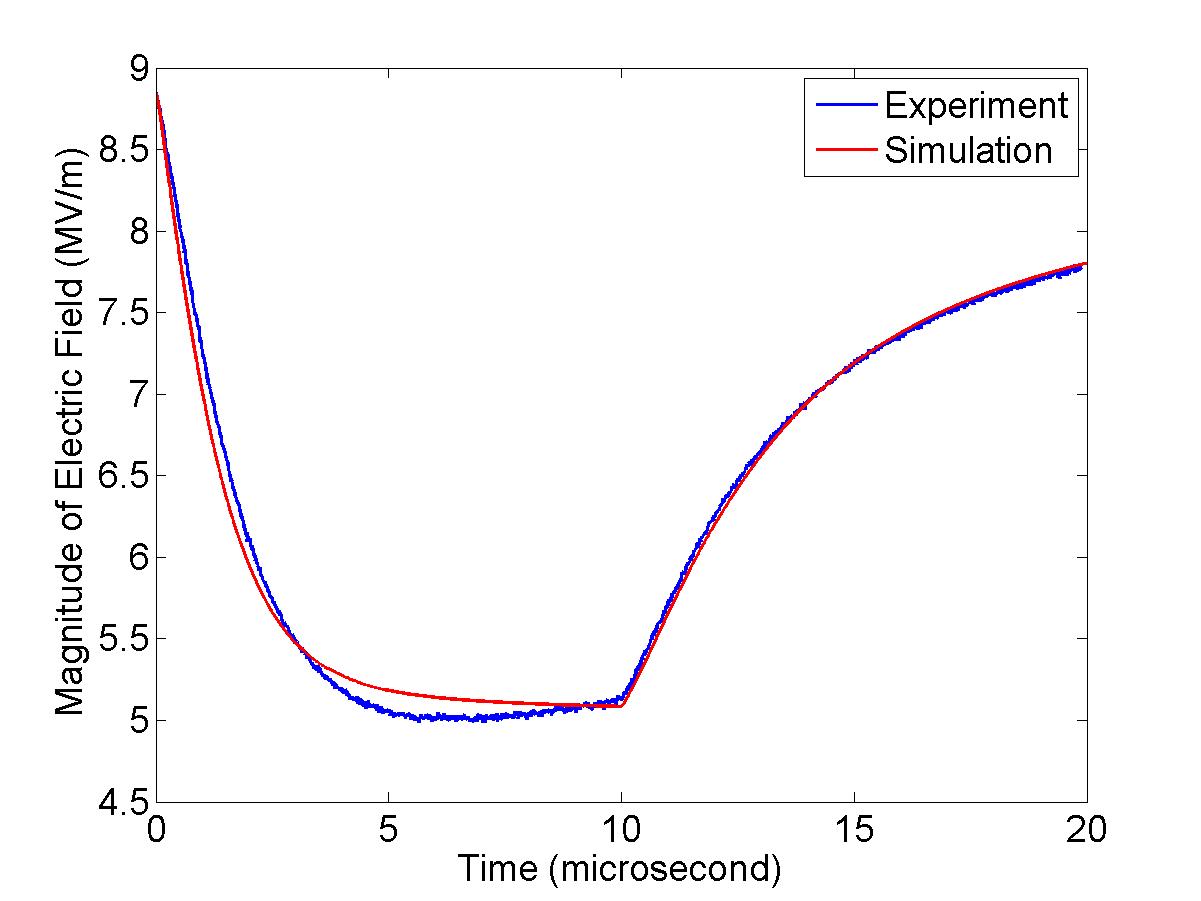Computational Science Laboratory Projects
Simulation Studies of Novel Methods for Cooling of Relativistic Particle Beams

Comparison of simulation and theory of the re-distribution of electron cloud in the vicinity of relativistic beam ions. Simulations are affected by the shot noise.
This LDRD project focuses on theoretical and experimental studies of the technique of Advanced Coherent electron Cooling (ACeC or Micro-Bunching e-Cooling, MBeC), an approach that promises to be superior to any of the current cooling schemes or proposed ones. Specifically, its cooling rate readily will suffice for cooling intense proton beams in the RHIC/eRHIC within a few seconds, and also sufficient for cooling the muon beams in the μ+ μ- collider. Research performed at CSC is aimed at in-depth simulation studies of the main components of the ACEC method, the modulator, the amplifier, and the kicker, and support of the theoretical and experimental program at CAD.
The main goal of the DOE MAP project is the feasibility study of a multi-TeV lepton collider and producing a well-defined intense neutrino beam for neutrino experiment. Because muons are a tertiary particle in production, the phase space volume of muon beam needs to be shrunken to fit into the accelerator optics. Ionization cooling is the only viable method for low energy muons to quickly cool down the beam temperature within their lifetime. Muons proparate through an ionization material with strong magnetic focusing and loose their kinetic energy via ionization process. The lost energy is immediately and adiabatically recovered by RF cavities. Better cooling efficiency is obtained with higher RF gradient. However, the achievable RF gradient is limited by the presence of a static magnetic field in a vacuum cavity because the density of dark current, which is a seed of electric breakdown in an RF cavity, is increased by magnetic focusing. To resolve this problem, a high-pressure hydrogen gas-filled RF (HPRF) cavity was proposed. Hydrogen gas serves the dual role: it buffers the dark current and serves as the ionization material for the cooling process.

Protons and isosurfaces of the magnitude of the electric field in plasma..

Time evolution of electric field magnitude by plasma loading in Fermilab HPRF cavity experiments: comparison of experimental and simulation results in 300 psi cavity containing 1% dry air doped gas.
SPACE, a 3D electromagnetic particle-in-cell (EM-PIC) code developed at BNL / SBU, is used for the simulation support of theoretical and experimental programs on Advances Coheren Electron Cooling at BNL and on the hydrogen gas filled RF cavity in the Mucool Test Area (MTA) at Fermilab. We have investigated the plasma dynamics in the RF cavity including the process of power dump by plasma (plasma loading), recombination of plasma, and plasma interaction with dopant material. By comparison with experiments in the MTA, simulations suggest several unknown properties of plasma such as the effective recombination rate, the electron attachment time on dopant molecule, and the ion – ion recombination rate in the plasma.
Recent Publications
K. Yu, R. Samulyak, M. Chung, A. Tollestrup, K. Yonehara, B. Freemire, Simulation studies of beam-induced plasma loading of high-pressure RF cavities, 2015, JINST, submitted.
K. Yu, R. Samulyak, SPACE Code for Beam-Plasma Interaction, IPAC-2015, 6th International Particle Accelerator Conference, May 3-8, 2015, Richmond, VA. Paper MOPMN016.
K. Yu, R. Samulyak, M. Chung, A. Tollestrup, K. Yonehara, B. Freemire, Simulation of Beam-Induced Plasma in Gas Filled Cavities, IPAC-2015, 6th International Particle Accelerator Conference, May 3-8, 2015, Richmond, VA. Paper MOPMN017.
J. Ma, R. Samulyak, V. Litvinenko, K. Yu, Simulation of Beam-Induced Plasma for the Mitigation of Beam-Beam Effects, IPAC-2015, 6th International Particle Accelerator Conference, May 3-8, 2015, Richmond, VA. Paper MOPMN019
K. Yu, R. Samulyak, M. Chung, A. Tollestrup, K. Yonehara, Modeling and simulation of beam-induced plasma in muon cooling devices, IPAC-2014, 5th International Particle Accelerator Conference, June 15 - 20, 2014, Dresden, Germany. Paper MOPME043
R. Samulyak, K. Yu, M. Chung, A. Tollestrup, K. Yonehara, R. D. Ryne, Algorithms for self-consistent simulations of beam-induced plasma in muon cooling devices, Proc. NA-PAC 2013, North American Particle Accelerator Conference, Sep. 29 - Oct. 3, 2013, Pacadena, CA, paper MOPBA06.




